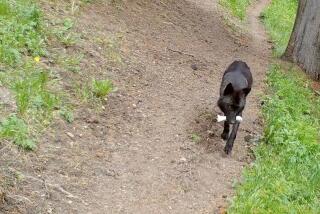Zoos Putting Polar Bear Boredom on Ice
- Share via
TOLEDO, Ohio — Gus in New York repeatedly swam figure-eight laps in his pool. Marty in Toledo paced the same path, carefully putting his paws in the same place each time.
Experts in animal behavior interpret such habits as signs of boredom or stress.
Keepers at the Toledo Zoo hope a new $11.5-million Arctic Encounters exhibit will give their bears, including Marty, more activity. Meanwhile, researchers at a dozen zoos throughout the nation are studying what stresses out polar bears.
The exhibit, which opened in January, features a freshwater stream where the bears can catch fish and a dirt pit where they can dig for food.
“Polar bears are fairly nomadic in the wild,” said Tim French, the zoo’s mammals curator. “Here we take care of everything so they’ve got too much time on their hands.”
The polar bears and seals--kept separately--also can splash around in four 300,000-gallon pools. By comparison, the old polar bear home was a small concrete pit with one 10,000-gallon pool.
Animal rights supporters, though, doubt the new four-acre enclosure can duplicate the expanse of the Arctic.
“Underneath all of the trappings, it’s still a concrete box,” said Naomi Rose, a mammal scientist with the Humane Society of the United States. “There are certain animals that are too large, too social and too intelligent to be held captive.”
In the wild, polar bears can cover 50 miles a day on the ground or in the water. Their lives center around roaming and searching for food, primarily seals.
They’re also extremely intelligent.
Marty, a 3-year-old, would balk at going inside at night. He used his body to block the door and also placed a small ball on the door’s sliding track, preventing the keepers from closing it.
Researchers suspect that polar bears show more signs of stress in captivity than other animals because they are so intelligent.
But what triggers their repetitive behavior is still a mystery.
One of the most famous cases of bear boredom was recorded in 1994 at New York’s Central Park Zoo when its polar bear Gus swam obsessively in his pool.
On the advice of animal behaviorists, the zoo created games for Gus, which cut into his swimming time. During the holidays, keepers gave him big boxes of toys and food to unwrap.
David Shepherdson, a program scientist at the Oregon Zoo in Portland, is overseeing a study that will examine whether polar bears in zoos have an increase in stress hormones that triggers the repetitive behavior.
Other zoos have had some success limiting that behavior with new exhibits geared toward entertaining the animals.
Polar bears at the San Diego Zoo pace much less since moving into a bigger, interactive enclosure more than three years ago. The drawback is that maintaining such elaborate enclosures is expensive and time consuming.
The new Toledo exhibit also allows the bears to look through a glass-bottom floor and watch the seals swim.
“We didn’t want to build a concrete cage and a swimming pool,” French said. “We wanted to build an area the animal could explore.”
A researcher will watch Marty and cubs Mizar and Alcor to develop a behavioral profile of the bears. The observations will help the zoo figure out what stimulates the bears.
“What seems to work best is changing the polar bear’s daily routine and giving it new things to explore,” said Bob Wilson, president of Polar Bears Alive.
The nonprofit organization, which works for the protection of the polar bear and its habitat worldwide, acknowledged that the zoos are improving the care of polar bears.
“It’s always going to be a battle to make their lives barely tolerable,” Wilson said.
More to Read
Sign up for Essential California
The most important California stories and recommendations in your inbox every morning.
You may occasionally receive promotional content from the Los Angeles Times.













